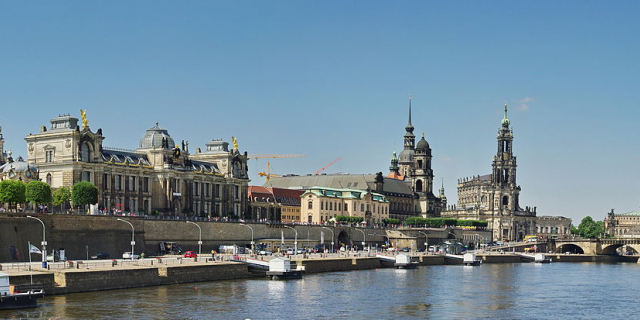The Dresden Frauenkirche (German: Dresdner Frauenkirche, IPA: [ˈfʁaʊənˌkɪʁçə], Church of Our Lady) is a Lutheran church in Dresden, the capital of the German state of Saxony. Destroyed during the Allied firebombing of Dresden towards the end of World War II, the church was reconstructed between 1994 and 2005.
An earlier church building was Catholic until it became Protestant during the Reformation. The old church was replaced in the 18th century by a larger Baroque Lutheran building. It is considered an outstanding example of Protestant sacred architecture, featuring one of the largest domes in Europe. It was originally built as a sign of the will of the citizens of Dresden to remain Protestant after their ruler had converted to Catholicism. It now also serves as a symbol of reconciliation between former warring enemies.
After the destruction of the church in ...Read more
The Dresden Frauenkirche (German: Dresdner Frauenkirche, IPA: [ˈfʁaʊənˌkɪʁçə], Church of Our Lady) is a Lutheran church in Dresden, the capital of the German state of Saxony. Destroyed during the Allied firebombing of Dresden towards the end of World War II, the church was reconstructed between 1994 and 2005.
An earlier church building was Catholic until it became Protestant during the Reformation. The old church was replaced in the 18th century by a larger Baroque Lutheran building. It is considered an outstanding example of Protestant sacred architecture, featuring one of the largest domes in Europe. It was originally built as a sign of the will of the citizens of Dresden to remain Protestant after their ruler had converted to Catholicism. It now also serves as a symbol of reconciliation between former warring enemies.
After the destruction of the church in 1945, the remaining ruins were left for 50 years as a war memorial, following decisions of local East German leaders. The church was rebuilt after the reunification of Germany, starting in 1994. The reconstruction of its exterior was completed in 2004, and the interior in 2005. The church was reconsecrated on 30 October 2005 with festive services lasting through the Protestant observance of Reformation Day on 31 October. The surrounding Neumarkt square with its many valuable baroque buildings was also reconstructed in 2004.
The Frauenkirche is often called a cathedral, but it is not the seat of a bishop; the church of the Landesbischof of the Evangelical-Lutheran Church of Saxony is the Church of the Cross. Once a month, an Anglican Evensong is held in English, by clergy from St. George's Anglican Church, Berlin.
 Dresden Market with the Frauenkirche (1749–1751 painting by Bernardo Bellotto)
Dresden Market with the Frauenkirche (1749–1751 painting by Bernardo Bellotto)A church dedicated to 'Our Lady' (Kirche zu unser Liebfrauen) was first built in the 11th century in a Romanesque style, outside the city walls and surrounded by a graveyard. The Frauenkirche was the seat of an archpriest in the Meissen Diocese until the Reformation, when it became a Protestant church. This first Frauenkirche was torn down in 1727 and replaced by a new, larger church with a greater capacity. The Frauenkirche was re-built as a Lutheran (Protestant) parish church by the citizenry. Even though Saxony's Prince-elector, Frederick August I, had converted to Catholicism to become King of Poland, he supported the construction which not only gave an impressive cupola to the Dresden townscape but also reassured the Saxonians that their ruler was not going to force the principle cuius regio, eius religio upon them.
The original Baroque church was built between 1726 and 1743, and was designed by Dresden's city architect, George Bähr, who did not live to see the completion of his greatest work.[1][2] Bähr's distinctive design for the church captured the new spirit of the Protestant liturgy by placing the altar, pulpit, and baptismal font directly centre in view of the entire congregation.
In 1736, famed organ maker Gottfried Silbermann built a three-manual, 43-stop instrument for the church. The organ was dedicated on 25 November and Johann Sebastian Bach gave a recital on the instrument on 1 December.
The church's most distinctive feature was its unconventional high dome, 67 metres (220 ft) high, called die Steinerne Glocke or "Stone Bell". An engineering feat comparable to Michelangelo's dome for St. Peter's Basilica in Rome, the Frauenkirche's 12,000-ton sandstone dome stood high resting on eight slender supports. Despite initial doubts, the dome proved to be extremely stable. Witnesses in 1760 said that the dome had been hit by more than 100 cannonballs fired by the Prussian army led by Friedrich II during the Seven Years' War. The projectiles bounced off and the church survived.
 View of Dresden by Moonlight (1839) by Johan Christian Dahl showing the Frauenkirche dominating the skyline
View of Dresden by Moonlight (1839) by Johan Christian Dahl showing the Frauenkirche dominating the skylineThe completed church gave the city of Dresden a distinctive silhouette, captured in famous paintings by Bernardo Bellotto, a nephew of the artist Canaletto (also known by the same name), and in Dresden by Moonlight (1839) by Norwegian painter Johan Christian Dahl.
In 1849, the church was at the heart of the revolutionary disturbances known as the May Uprising. It was surrounded by barricades, and fighting lasted for days before those rebels who had not already fled were rounded up in the church and arrested.
For more than 200 years, the bell-shaped dome stood over the skyline of old Dresden, dominating the city.
Burials include Heinrich Schütz and George Bähr.



































Add new comment